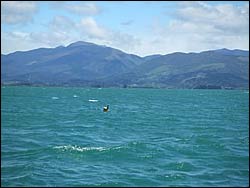Marine modelling – how are we doing?
28/06/2007 |
| Monitoring buoy off the Motueka River mouth |
Preliminary modelling effort was directed to modelling of physical characteristics (currents, salinity, temperatures...) of the bays from etereological/terrestrial/riverine inputs using numerical models.
Initially this work was used to investigate linkages between river sediment loads and the consequent distribution in the marine environment. Since this preliminary work, Weimin Jiang and Mark Gibbs have also undertaken foodweb studies into the distribution of biomass within the bay ecosystems to estimate the effects of aquaculture encroachment on water–column biomass in order to assess an ecological carrying capacity for the bay (W Jiang and M Gibbs – J. Aquaculture, 2005). This work has also provided a base from which to pursue the greater aims of the modelling studies, ie. the prediction of effects of importance to coastal stakeholders so that appropriate land, freshwater, and near–coastal management descisions can be made in future. As the aims of the project rely heavily on "upstream" effects and ultimately what the stakeholders want, a separate objective encapsulated by an "Integrated Dynamic Environmental Assessment System" (IDEAS) theme.
This IDEAS group is formed of a core group of multi–disciplinary modelers and facilitators from catchment, freshwater, economic, social and marine backgrounds that has been set up in order to integrate and target the modelling effort into a "one–stop–shop" to answer the questions coastal stakeholders want to know.
How does the system respond to nutrient–changes now?
Analysis of satellite data sets suggests – from a primary production perspective – that the surface waters in Tasman Bay are currently in a nutrient limited regime, therefore nutrient enrichment around the current levels would cause an increase in the surface of the water column production.
Given the current state of the marine environment, what was it like before Europeans/humans arrived?
From a nutrient perspective Land–care research indicates approximately half the Nitrogen load would have existed, given a nutrient–limited regime we would therefore expect approximately half the production in the surface waters (note given the complexity of oceanic interactions with the bay we cannot state with any certainty how this compares to the total production in the bay). This has interesting implications for aquaculture in the bay as it provides a level for which production and export of product (scallops/mussels) and the associated Nitrogen (in the form of amino acids/protein) may help in shifting net nutrient levels back to historic levels.
What could change in the future?
This is where it gets tricky! Extreme land use nutrient modelling scenarios created by Landcare show the possibility for nutrient loading of up to seven times the current levels. An assumption of nutrient limitation for surface waters may not hold for these type of extreme scenarios. As such, a modelling effort is being undertaken to assess
possible effects of high nutrient loadings. Will light become limiting for production? Could we see the sort of "Dead–zone" anoxic effects they see around the Mississippi?
There are almost limitless questions that can arise with this question and ultimately we intend to find out what is important to the stakeholders before we enter into this research without clear objectives. Initially to assist in engaging stakeholders in the type of outcomes they could pursue, Ben Knight (Cawthron) is creating a reasonably simple mono–culture, nitrogen/light driven model of algae in the coastal water column to assess large changes in riverine input loads on primary production in an area around the Motueka Plume. This information is in turn being fed into a farm–scale mussel model to assess the impacts to mussel production within Aquaculture Management Areas that will be situated close to the river plume in future. It is intended that the effects of associated E coli–events on harvest days will also be included to show an educative example of incremental cost/benefits to a coastal stakeholder from differing land uses and practices.
Key Contact:

|
Ben Knight
Email Cawthron Institute More details» |
Expertise Biophysical systems specialist |